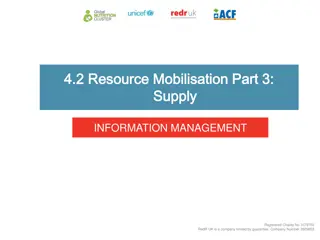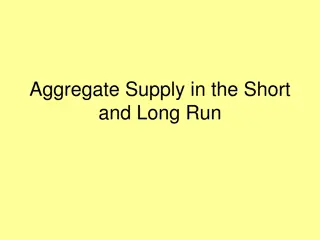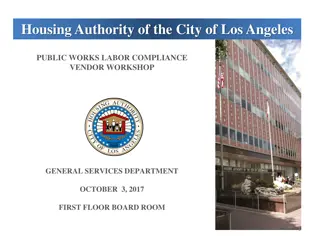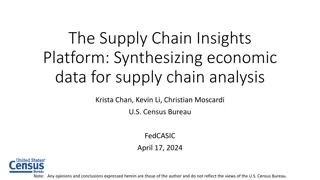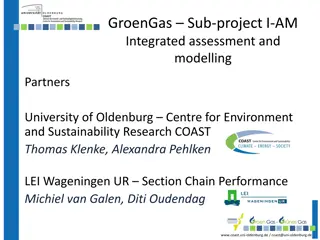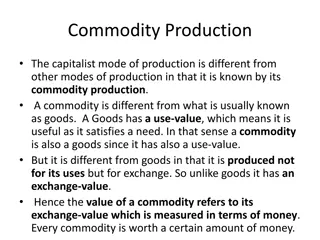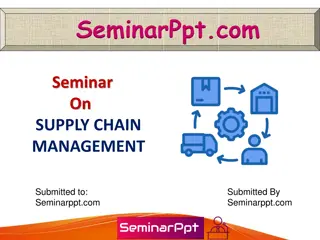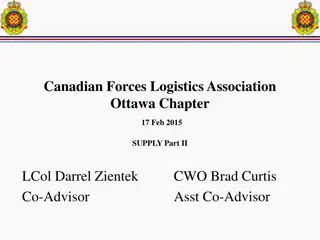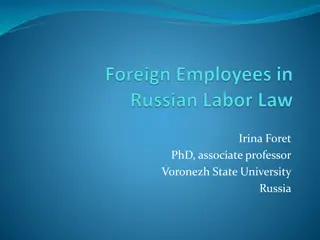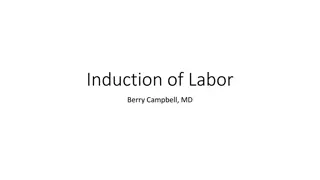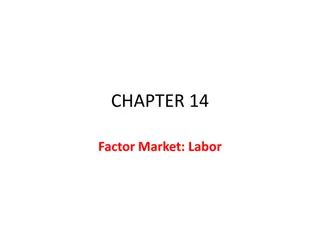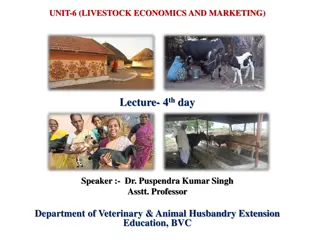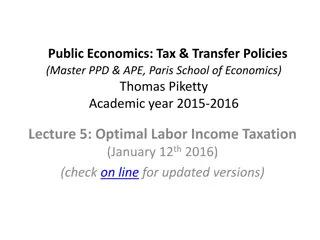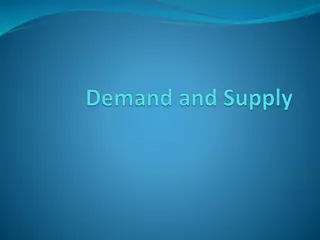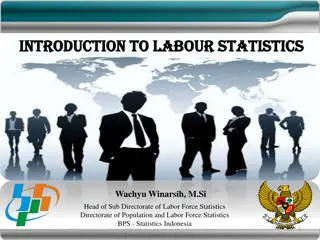Debates on the Mode of Production in Indian Agriculture
Dr. S. Mehdi Abbas Zaidi and Ms. Bushra Fatima discuss the elements of production in Indian agriculture, including the objects of labor, instruments of labor, and the role of labor itself. They explain how these components interact to form the productive power of labor and shape the relations of pro
1 views • 19 slides
The Art and Science of Demand and Supply Chain Planning: Navigating Today's Global Economy
Explore the intricacies of demand and supply chain planning in the modern global economy through the insightful content provided in this book. From achieving supply and demand balance to adapting to uncertainties like navigating white water rapids, the text delves into strategies for improving accur
2 views • 201 slides
Guidelines for Induction of Labor in Family Medicine Forum 2023
The new SOGC Induction of Labor Guidelines 2023 were introduced at the Family Medicine Forum by Dr. Hannah Shenker and Dr. Helen Mavromichalis from McGill University. The presentation discussed various scenarios for inducing labor and highlighted key recommendations, including the importance of shar
0 views • 41 slides
Employment and Labor Law in Russia: Overview and Legal Rights for Foreigners
Irina Foret, PhD, an associate professor at Voronezh State University, provides valuable insights into the general issues surrounding employment and labor law in Russia, with a focus on the legal status of foreigners, work permits, and protection of labor rights. The Russian Federation extends right
2 views • 27 slides
INVENTORY MANAGEMENT.
Managing inventory under ISO 15189 guidelines involves Quantity, Quality, and Process management. Key aspects include demand forecasting, inventory movement control, consumption planning, and ensuring fitness for purpose. Quantity management aims to balance demand and supply, manage supply economics
5 views • 13 slides
Alabama Child Labor Law Guidelines
Alabama's Child Labor Law establishes regulations concerning the minimum age to work, exemptions for certain types of work like lemonade stands and agriculture, requirements for Child Labor Certificates, eligibility criteria for minors aged 14 and 15, the necessity of displaying labor law posters, r
1 views • 28 slides
Responsibilities and Collaboration in Supply Management for Emergency Response
The role of various stakeholders in supply management for emergency response is crucial. The Nutrition Cluster Coordinator (NCC) coordinates with partners to identify and address supply needs, while Information Management Officer (IMO) supports in calculating caseloads and consolidating supply reque
1 views • 24 slides
Understanding Aggregate Supply in the Short and Long Run
Aggregate Supply in the short and long run is crucial in understanding the relationship between the economy's price level and the total quantity of goods and services produced. In the short run, sticky wages and production costs play key roles in determining supply levels, while in the long run, cha
0 views • 16 slides
Public Works Labor Compliance Vendor Workshop by Housing Authority of the City of Los Angeles
The Housing Authority of the City of Los Angeles conducted a workshop to assist contractors in understanding their Public Works labor compliance responsibilities. The workshop covered topics such as contractor responsibilities, registration with the state under SB854, federal and state labor laws, a
1 views • 26 slides
Understanding Supply and Demand in Economics
Explore the fundamental concepts of supply and demand in economics, including the laws that govern them. Learn about the characteristics of free markets, the factors that determine supply, and how prices influence the quantities supplied and demanded. Gain insights into the law of supply and law of
1 views • 21 slides
Overview of Labor Law and Union Formation Process
Labor law governs the structure and operations of private labor relations in the United States. The National Labor Relations Act (NLRA) establishes the National Labor Relations Board (NLRB) to handle unfair labor practices in the private sector. The process of forming a union involves reaching out t
0 views • 11 slides
Economics of Labor Markets: Factors of Production and Labor Demand
The Economics of Labor Markets explores the markets for factors of production such as labor, land, and capital. Demand for these factors is derived from firms' decisions to produce goods. The labor market, governed by supply and demand forces, exhibits diminishing marginal product of labor due to fi
0 views • 41 slides
Understanding Unfair Labor Practices vs. Grievances at FLRA, NLRB, and DC PERB
Unfair labor practices (ULPs) are violations of federal labor laws, while grievances involve disputes between labor organizations and agencies. Different reviewing authorities handle these matters: FLRA for federal, NLRB for private sector, and DC PERB for DC government agencies. Each organization h
0 views • 47 slides
Introduction to Supply Chain Management
Explore the key components of supply chains, the importance of supply chain management technology, and strategies to overcome challenges. Learn about supply chain visibility, the structure of supply chains, and the three segments - upstream, internal, and downstream. Discover how organizations acces
1 views • 29 slides
Enhancing Supply Chain Insights Through Holistic Data Synthesis
Synthesizing economic data for comprehensive supply chain analysis, this talk by Krista Chan, Kevin Li, and Christian Moscardi from the U.S. Census Bureau discusses the goals, challenges, supply chain interests, data sources, and desired functionalities to present a holistic view of product supply c
0 views • 16 slides
Integrated Assessment and Modelling for Sustainable Biogas Supply Chains
The GroenGas sub-project I-AM focuses on integrating and synthesizing results from various sub-projects to assess innovations and improvements in biogas supply chains. The project aims to implement powerful options for sustainable supply chain management, including performance analysis, benchmarking
0 views • 14 slides
Understanding Commodity Production and Labor in Capitalist Mode
The capitalist mode of production is characterized by commodity production, where goods are produced not for their use but for exchange. The value of a commodity is determined by its exchange value, measured in money, which is influenced by the quantity of labor involved in its production. Labor, be
0 views • 8 slides
Understanding Supply in Economics
Explore the definition of supply, changes in supply versus changes in quantity supplied, non-price determinants of supply, the supply curve, key outcomes to know, and real-world examples affecting gasoline supply. Develop a strong foundation in economic concepts with detailed explanations and graphi
0 views • 33 slides
Understanding Supply in Economics
Explore the concept of supply in economics, including its definition, determinants, and graphical representation. Learn about the law of supply, non-price factors affecting supply, and key terms such as market supply and horizontal summation. Understand the difference between a change in quantity su
0 views • 30 slides
Understanding Supply in Economics
Supply in economics refers to the quantity of goods that firms are willing to produce at different prices over a specific period. The Law of Supply states that as prices increase, the quantity supplied by firms also increases. Individual and market supply curves illustrate this relationship, with ot
0 views • 28 slides
Understanding Supply and Costs of Production in Economics
Supply in economics refers to the availability of goods and services in the market, influenced by factors like the law of supply, supply schedules, and supply elasticity. Cost of production involves considering marginal benefits and costs in determining output levels. These concepts are vital in und
0 views • 20 slides
Enhancing Supply Chain Security and IT Governance: An Overview
This presentation delves into the critical aspects of supply chain security and IT governance, highlighting the synchronization of IT decisions across supply chains, global supply chain concerns, the cost implications of supply chain security lapses, and the need for more research and strategic alig
0 views • 28 slides
Understanding Supply Chain Management: Key Concepts and Processes
Supply chain management (SCM) involves the centralized management of goods and services flow, covering processes from raw materials to final products. By efficiently managing the supply chain, companies can reduce costs and improve product delivery. This seminar presentation explores the definition,
0 views • 24 slides
Understanding Goods and Services Tax (GST) Time of Supply
Goods and Services Tax (GST) time of supply, also known as TOS, determines when GST becomes payable on a supply. This includes various elements like agreement to supply, delivery of goods, provision of services, invoice issuance, payment, and recording of payments. The time of supply for goods and s
0 views • 26 slides
Canadian Forces Logistics Association Ottawa Chapter Update
The Canadian Forces Logistics Association Ottawa Chapter provided updates on supply chain management, officer courses, qualification updates, and riggers' career path. They discussed initiatives such as Supply Update Roadmap, Supply Relationships Geographic Map, Supply Officer and Supply Tech update
0 views • 11 slides
Comprehensive Guide to the Management of Normal Labor by Professor Muhsin-AL-Sabbak
Understanding the management of normal labor is crucial for healthcare professionals. This comprehensive guide covers the definition of normal vaginal delivery, diagnosis of labor, stages of labor, phases of labor, and the use of tools like partogram and cardiotocography to monitor progress. Profess
0 views • 9 slides
Physiology of Labor: Onset and Key Hormonal Changes
Labor, or parturition, involves uterine contractions leading to the fetus's expulsion. Factors triggering labor include hormonal changes like increased estrogen and decreased progesterone, which stimulate uterine muscle activity. Telocytes play a role in spontaneous uterine activity, while oxytocin
0 views • 36 slides
Migration Policies and Labor Laws in Russia: A Comprehensive Overview
Irina Foret, PhD, an associate professor at Voronezh State University, delves into the legal status of foreigners in Russia, including work visas, labor rights violations, and legal remedies. Key aspects such as Article 62 of the Constitution and Article 11 of the Labor Code are discussed, highlight
0 views • 30 slides
Impacts of Labor Productivity by Age and Changes in Age Structure on Labor Productivity in Vietnam
This research focuses on quantifying the impact of labor productivity by age on the overall economy's labor productivity in Vietnam. Utilizing analytical methods like the Cobb-Douglas production function and Shift-Share Analysis, the study aims to understand how changes in age structure and labor sh
0 views • 26 slides
Induction of Labor: Methods and Considerations
Induction of labor is done to achieve vaginal delivery before spontaneous onset, usually at 39 weeks or when medically necessary. Risks include failed induction, cesarean section, uterine rupture, prolonged labor, and infections. Cervical ripening methods help prepare the cervix for labor. The Bisho
0 views • 18 slides
Understanding Competitive Factor Market in Labor Economics
A competitive factor market involves a large number of sellers and buyers of a factor of production, like labor. With no single entity influencing prices, each acts as a price taker. The demand for factors depends on firms' output levels and input costs, leading to derived demands. Profitability of
0 views • 43 slides
Understanding Labor Productivity Growth in Europe: Insights from Productivity Project Conference
Divergent experiences in labor productivity growth between the US and Europe have sparked interest in analyzing factors affecting productivity. The Productivity Project Conference in January 2015 delved into macro and micro-level determinants of labor productivity, focusing on Total Factor Productiv
1 views • 27 slides
Department of Employment and Labour: Vision, Mandate, and Objectives
The Department of Employment and Labour aims to regulate the labor market through policies focusing on economic efficiency, decent employment, labor standards, and social safety nets. The department's vision is to create a conducive labor market for investment, economic growth, employment, and decen
0 views • 35 slides
China-Africa Supply Chain Cooperation: Challenges and Opportunities
China-Africa Supply Chain Cooperation presents both challenges and opportunities for development. The growth of China-Africa supply chain is crucial, considering Africa's participation in the global supply chain mainly focused on providing primary products. The strategic importance of this relations
0 views • 19 slides
Understanding Price Elasticity of Supply in Economics
Price elasticity of supply measures how much the quantity supplied responds to changes in price. It can be inelastic (quantity supplied responds slightly), elastic (quantity supplied responds substantially), or unit-elastic (price elasticity of supply equals 1). Various determinants like the passage
0 views • 16 slides
Understanding Livestock Economics: The Law of Supply Explained
Exploring the concept of supply in livestock economics, this lecture covers theories, individual supply schedules, market supply schedules, and the law of supply. Dr. Puspendra Kumar Singh delves into the relationship between commodity prices and producer supply, offering insights into market dynami
0 views • 30 slides
Understanding Abnormal Labor and Prolonged Labor in Childbirth
Labor is considered abnormal when there is poor progress or signs of compromise in the fetus. Prolonged labor, lasting more than 18 hours, may result from various factors affecting cervical dilatation and descent of the presenting part. Causes include issues with power, passage, and passenger. Diagn
0 views • 20 slides
Optimal Labor Income Taxation: Main Theoretical Results and Intuitions
The optimal taxation of labor income involves a U-shaped pattern of marginal tax rates, with top rates influenced by income concentration and labor supply elasticities. Mirrlees' model analyzes optimal labor income taxes based on productivity and labor supply decisions, aiming to maximize social wel
0 views • 24 slides
Understanding Demand and Supply in Economics
Demand and supply are core concepts in economics, driving the market economy. Demand reflects the desire for a product at different prices, with an inverse relationship between price and quantity demanded. Supply, on the other hand, represents what producers are willing to offer at various prices, w
0 views • 7 slides
Understanding Labour Statistics in Indonesia
Labour statistics play a crucial role in understanding the dynamics of the labor market in Indonesia. These statistics provide insights into various aspects such as labor demand, supply, different forms of work, economic contributions, and household livelihoods. By monitoring participation in employ
0 views • 21 slides






